As with April Love, Ruskin was delighted: “A very noble painting […] Madeline’s face is exquisite.” In 1857, he collaborated with Burne-Jones, Rossetti, and Morris in painting the walls of the Oxford Union Library. The following year, he moved to London, then travelled to Italy in 1862. At various times in his life, Hughes held teaching posts at South Kensington Schools and Working Man’s College. The last exhibition of his works while he was still living took place at the Royal Academy in 1908. He spent the last years of his life in isolation surviving on a Civil List Pension, and he died in Kew, not far from central London. Hughes was never part of the Pre-Raphaelite Brotherhood, but was very close to all the members and embraced their principles quite early. Though timid and reserved, he was much appreciated by the Brothers and was one of their most faithful followers.
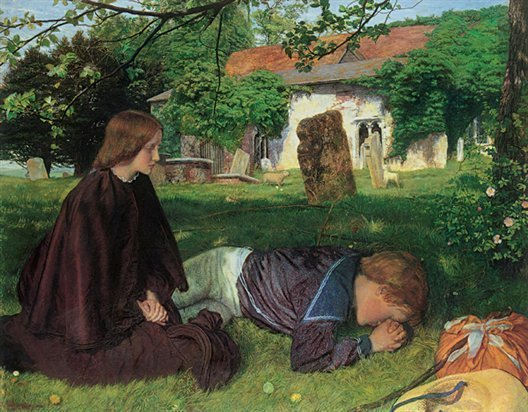
Arthur Hughes, Home from Sea, 1863.
Oil on panel, 50 x 65 cm.
The Ashmolean Museum of Art and Archaeology,
University of Oxford, Oxford.
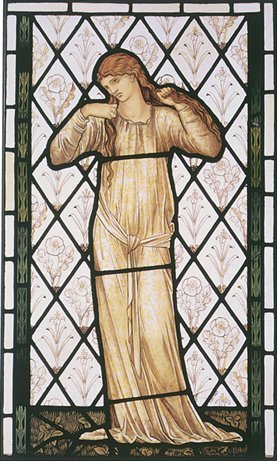
Edward Burne-Jones (design) and Morris,
Marshall, Faulkner & Co. (production), Elaine, 1870.
Stained and painted glass, 86.3 x 51.4 cm.
Victoria & Albert Museum, London.
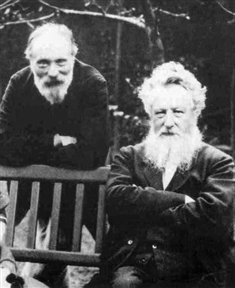
Anonymous,
Portrait of Burne-Jones and Morris.
Private Collection
Sir Edward Burne-Jones
(Birmingham, 1833 - West Stratton, 1898)
Ned Burne-Jones was an only child. He lost his mother a few days after his birth and was raised by his Welsh father, who was deeply affected by the death of his wife and had difficulty accepting the presence of his son. Consequently, the young Edward was often left to himself and found comfort in drawing. From 1844 he studied at King Edward’s School in Birmingham; at first envisaging a career in commerce, he nevertheless studied the classics, and would maintain this interest throughout his life. His fascination with mythology was particularly lasting. Additionally, the young Burne-Jones loved painting and his work showed promise. In Birmingham, his drawing teacher was Thomas Clark, a landscape painter who exhibited at the Royal Academy. In January 1853 he entered Exeter College, Oxford at the same time as William Morris who, like him, was attracted by the Oxford Movement and wanted to enter the priesthood. They had a deep friendship and shared a passion for the Middle Ages as well as for the writings of Thomas Carlyle and John Ruskin. Soon, Burne-Jones took up painting and drawing again. He studied Italian paintings and engravings by Dürer in the University galleries, but felt the greatest enthusiasm for the works of a contemporary English painter, Rossetti. Like Morris, Burne-Jones decided to abandon his aspirations to the priesthood to pursue his artistic career.
In 1856 he met Rossetti, who became his mentor, and left the University shortly thereafter to take up residence in London. He moved to 17 Red Lion Square with Morris, into an apartment formerly occupied by Rossetti, from whom he had taken informal lessons. Rossetti strengthened their desire to reintroduce the formal purity, stylisation, and high moral value of medieval art works into contemporary art. In the same year, Burne-Jones met his future spouse Georgiana (Georgie) MacDonald, the sister of a school friend and the daughter of a Methodist minister. Recognising his student’s talent, Rossetti soon declared that he had nothing more to teach Burne-Jones, and in the autumn of 1857 they worked together decorating the walls of the Oxford Union. However, none of the painters involved had mastered the fresco technique, and the paintings were already crumbling soon after their completion. In 1859 Burne-Jones travelled to Italy and visited Florence, Pisa, Sienna, and Venice. By the end of the 1850s, Burne-Jones’ work was stylistically similar to that of Rossetti. His feminine ideal was also similar to Rossetti’s, characterised by abundant hair, strong chins, long necks and androgynous bodies hidden under large medieval robes. In 1860 he painted the two portraits Sidonia von Bork and Clara von Bork, then in June of that year he married Georgiana, whose sisters had married Sir E. Poynter, the future President of the Royal Academy, and Lockwood Kipling, father of Rudyard Kipling. The couple’s home was in Bloomsbury.
In 1861 Burne-Jones was a founder of Morris, Marshall, Faulkner and Co., for whom he was the principal stained-glass artist, creating more than five hundred designs.
Though he was most strongly influenced by Rossetti, he also benefited from contact with other artists such as G.F. Watts. In 1862 Burne-Jones and Georgiana accompanied Ruskin on a trip to Milan and Venice.
In 1864, watercolours including the Merciful Knight (1863) earned him election to the Royal Watercolour Society. His adored daughter Margaret was born in 1866, and she became his confidante and a frequent model for his paintings. In 1870, after a conflict, Burne-Jones stepped down from the Royal Watercolour Society. His affair with Mary Zambaco, one of his models, provoked a scandal, and these successive problems incited him to retire to Fulham, west London.
Two successive voyages in Italy in 1871 and 1873 enriched his knowledge of the High Renaissance. In 1877 he triumphed at the Grosvenor Gallery with The Beguiling of Merlin and The Mirror of Venus. In 1886 he took part in the annual exhibition of the Arts and Crafts Society, where he exhibited numerous works created for Morris. These works attained high prices at auction, and people began to collect his designs.
In 1889, after his success at the Paris Universal Exhibition, he was awarded the Légion d’Honneur by the French government, and in 1894 he was raised to the baronetcy by the Queen. In 1895, though already ill, he executed fifty-seven illustrations for the The Works of Geoffrey Chaucer, published by Morris’ Kelmscott Press. However, his health was slowly failing him and in 1898 he died of cardiac arrest.
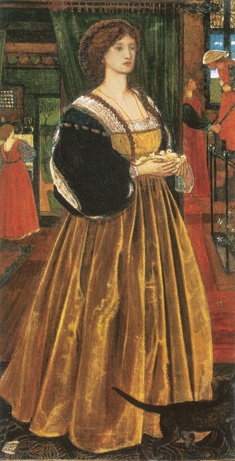
Edward Burne-Jones,
Clara von Bork 1560, 1860.
Watercolour and gouache, 34.2 x 17.9 cm.
Tate Britain, London.
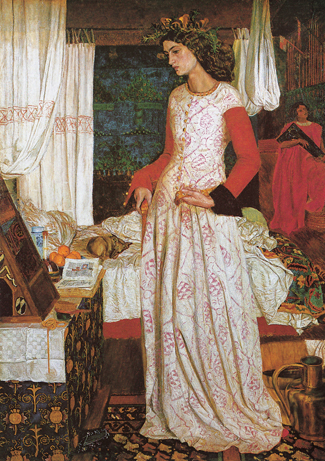
William Morris, La Belle Iseult, 1858.
Oil on canvas, 71.8 x 50.2 cm.
Tate Gallery, London.
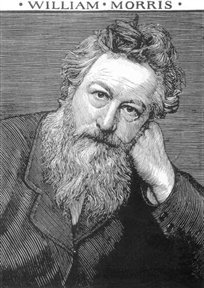
Anonymous, Portrait of William Morris.
Private Collection.
William Morris
(Walthamstow, 1834 - Kelmscott, 1896)
William Morris was a designer, poet, decorator, writer, and architect. He was the third of nine children of William Morris, a rich Lombard Street broker, and his wife Emma. He learned to read very early, and at four years old he was already familiar with all of Sir Walter Scott’s novels. He studied with his sisters’ governess and went to school for the first time at nine years old. In 1848, after the death of his father, William entered Marlborough College, where he was influenced by the Oxford Movement. It was in this same year that the Pre-Raphaelite Brotherhood was founded.